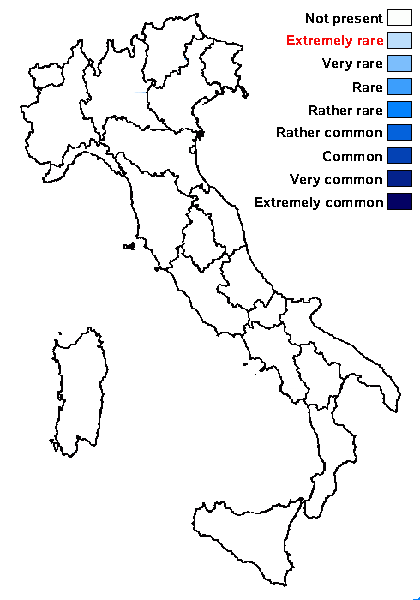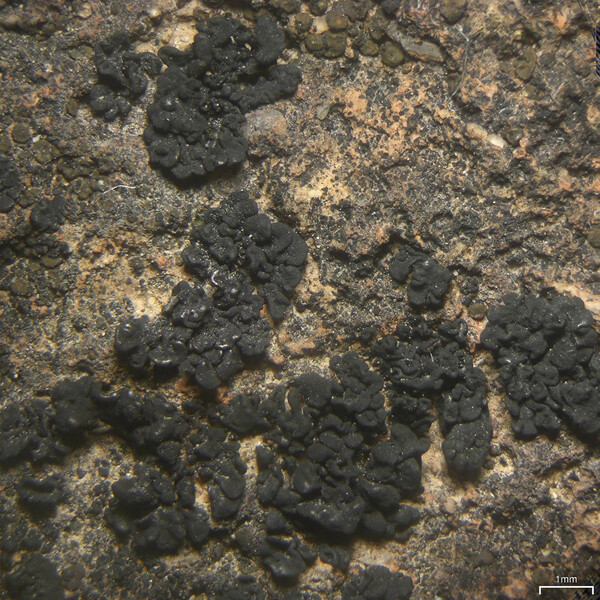Lichinella sinaica (Galun & Marton) P.P. Moreno & Egea
Cryptogamie Bryol.-Lichénol., 13, 3: 248, 1992. Basionym: Gonohymenia sinaica Galun & Marton - Bryologist, 73, 2: 378, 1970
Synonyms:
Distribution:
Description: Thallus very variable, from squamulose-peltate to subfruticose, mono- or polyphyllous, 300-550 µm thick, gelatinous when wet, black when dry, olive-brown when wet, forming up to 1-1.5 cm wide and 0.5-0.6 mm tall cushions attached by bundles of rhizohyphae or by a central holdfast; lobules erect, 2-6 mm tall, 0.3-0.5 mm wide, cylindrical or slightly flattened, simple or sparingly branched, smooth or granulose. Outer part of squamules (in section) 60-80 µm wide, formed by 2-3.5 µm thick, mainly anticlinally oriented hyphae enclosing the photobiont cells, the medullary part of very loosely arranged, 1-2 µm thick hyphae with cylindrical cells, the basal part forming a denser strand of irregularly arranged hyphae. Apothecia thallinocarps, hemiangiocarpous, the ascogonia arising freely beneath the thallus surface, immersed and difficult to recognize unless when wet, terminal, 0.3-0.6(-0.8) mm across, with a convex, fissured disc and a poorly evident, up to 50 µm wide thallline margin. Proper exciple indistinct; epithecium brownish, discontinuous, 12-20 µm high; hymenium 75-110 µm high, separated into partial compartments by wedges of photobiont cells from the epithecium, covered by a irregularly thick layer of sterile tissue and a layer of photobiont cells, K/I+ blue turning wine-red; subhymenium continuous, 20-50 µm high. Asci 16-24(-32)-spored, subcylindrical to obclavate, prototunicate, with a thin, one-layered, non-amyloid wall, an amyloid external apical cap, and passive spore discharge via apical rupturing, Lichina-type. Ascospores 1-celled, hyaline, broadly ellipsoid to subglobose, 4-9 x 3-5 µm. Photobiont cyanobacterial, chroococcoid, with clusters of 2-6 cells measuring 5-10 x 3-6 µm penetrated by haustoria and surrounded by a brownish gelatinous sheath. Spot tests: all negative. Chemistry: without lichen substances.
Note: a species described from the Middle East and also known from NE Africa, the SE part of the Iberian Peninsula, and the Sonoran Desert, growing on steeply inclined surfaces or more or less calciferous or basic siliceous rocks, often on thin layers of sand in rock fissures, in dry, sunny sites with periodical water seepage after rain. To be looked for in the driest parts of Mediterranean Italy.
Growth form: Squamulose
Substrata: rocks, soil, terricolous mosses, and plant debris
Photobiont: cyanobacteria, coccaceous (e.g. Gloeocapsa)
Reproductive strategy: mainly sexual
On otherwise dry surfaces with short periods of water seepage after rain

Predictive model
Growth form: Squamulose
Substrata: rocks, soil, terricolous mosses, and plant debris
Photobiont: cyanobacteria, coccaceous (e.g. Gloeocapsa)
Reproductive strategy: mainly sexual
On otherwise dry surfaces with short periods of water seepage after rain

Predictive model
 INDEX FUNGORUM
INDEX FUNGORUM
 GBIF
GBIF


